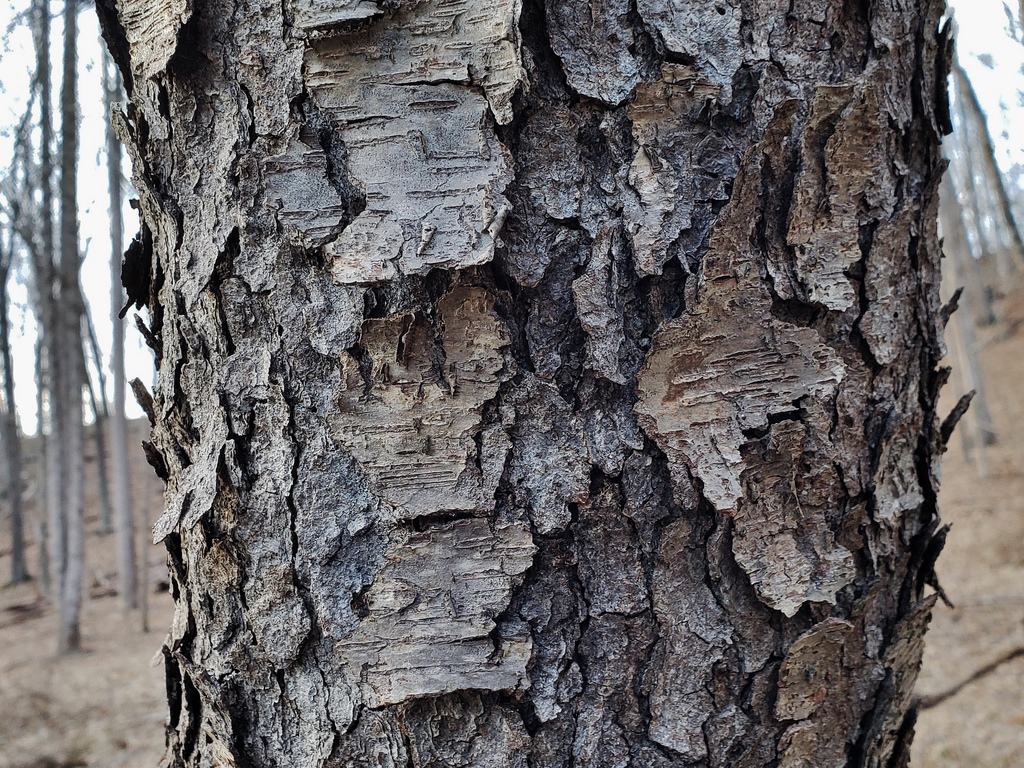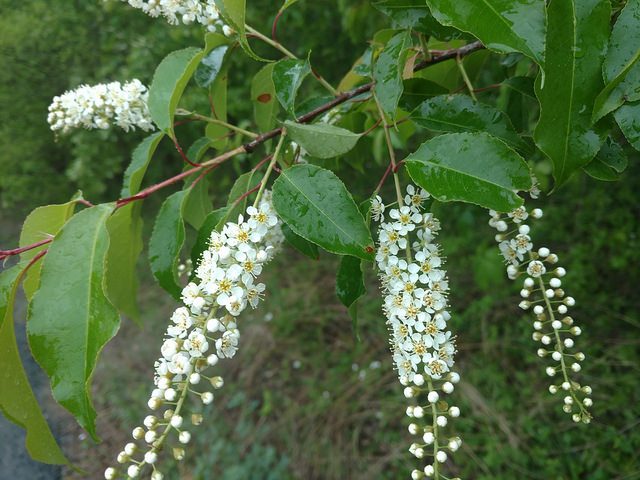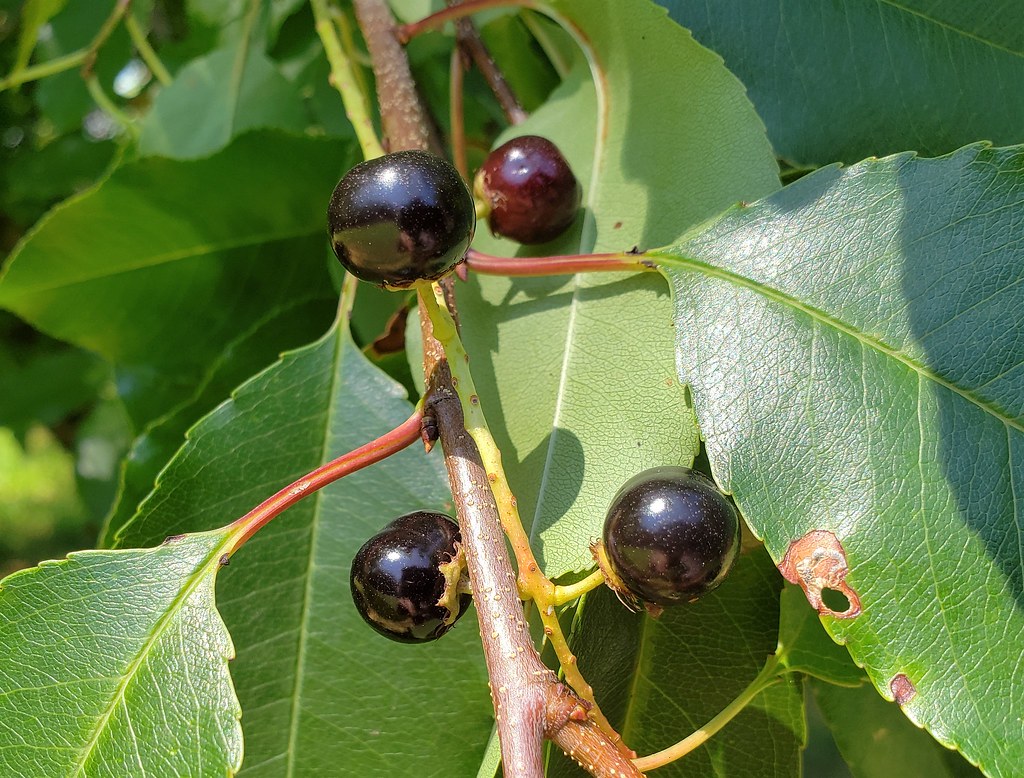Black Cherry
Prunus serotina Ehrh.
Description
Black cherry, also known as a wild cherry or mountain black cherry, is a member of the rose family (Rosaceae). The tree starts out very cone shaped and grows 25-110 ft tall. Black cherry trees grow tall and slender when growing close to each other, but in open growth the tree is over hanging, with arching branches¹. The southwestern varieties in North America can sometimes be shrubs¹. Black cherry leaves are shiny on the upper side, with a flat and curved, oblong blade and finely toothed edges (serrated) with a pointed tip. Mature leaves often have reddish hairs along the midrib on the lower side. The glands at the base of the leaf blade are small. The leaves emerge with a red tint and develop a deeper green as they mature². Leaves are deciduous and in fall turn yellowish and orange.
White flowers emerge after leaves develop out in the spring from late May to early June in Maryland for 14-21 days6. They form racemes of 20 or more flowers. The fruits turn from dark red to black in August to October¹.
Black cherry bark starts out smooth and reddish brown with conspicuous lenticels, and as the tree matures its bark will break into curling outward scales². The bark of a mature black cherry is one of the best ways to identify the tree. This tree produces a cherry aroma from both its crushed leaves and bark. The tree can also be poisonous since its bark, roots and leaves have concentrations of cyanogenic toxic compounds.

Mature bark of black cherry showing scales and lenticels. Photo @ M Beziat, 2019, Maryland Biodiversity Project5

Flowering inflorescences of Black Cherry. Photo @ W. Longbottom, 2017. Maryland Biodiversity Project5

Black cherry fruits and serrated leaves. Photo @ M Beziat, 2019, Maryland Biodiversity Project5
Distribution
Black cherry is mainly found along the eastern coast of North America from Florida to Nova Scotia, southern Canada and western Minnesota to eastern Texas. A variety is found in central Mexico and South America. In Maryland, one can find this tree in every county.

Native distribution of black cherry. USDA4
Wildlife importance
Raccoons and black bears climb black cherry trees to retrieve their berries². Its berries are known to feed many mammals and at least 33 species of bird¹. Their attractive leaves entice butterflies and many birds. The tree provides nectar and pollen which attract honeybees and bumblebees, it is also a great larval host. Black cherry is a great source of food for many insects. White-tailed deer and moose feast on leaves and twigs during the fall and winter, and these animals spread the seeds to new areas².
Economic importance
Black cherry’s wood is considered very valuable for its color; it is used for furniture, instruments, paneling, toys and handles. The bark provides a cough medicine; wild cherry syrup, while its fruit is used to make jelly and wine and can be used as a seasoning as well. The cherries are also pitted and eaten raw. Its fruits and bark are safe for consumption; however, the rest of the plant can be toxic when ingested¹. Most say to avoid any almond like smell which is a sign of cyanide.
Threats
Black cherry has a low fire risk. Black cherry is susceptible to diseases and insect pests. Cherry is susceptible to the eastern tent caterpillar (Malacosoma americanum), which can cause defoliation during heavy outbreaks4. It is also susceptible to black knot disease caused by a fungus (Apiosporina morbosa) that can ultimately kill the tree4.

Black Knot disease on black cherry. Science ABC7
Interesting facts
- As early as 1629, this tree was one of the first New World trees introduced into Europe, but now is highly invasive in European countries and northern South America¹.
- The tree was referred to as a rum cherry tree, this was when Appalachian pioneers used the fruits to flavor their brandy or rum, the drink was called a cherry bounce².
- Ingesting certain parts of this plant is toxic to humans³.
- The black cherry tree is insect pollinated. Self-pollinated flowers do not develop viable seeds 4
- This tree lives in the wild for 150 to 200 years, and the best fruits are produced from ages 30 to 100 years old4.
References
- Lady Bird Johnson Wildlife Center: Prunus serotina
- Trees of the Adirondacks: Black cherry (Prunus serotina)
- North Carolina State Estension: Prunus serotina
- USDA-Forest Service, Silvics, Volume 2 Hardwoods: Prunus serotina
- Maryland Biodiversity Project: Black cherry
- Honey plants: Black cherry
- SoftSchools: Black cherry facts
Contributed by E. Sawyers and J. Singh
